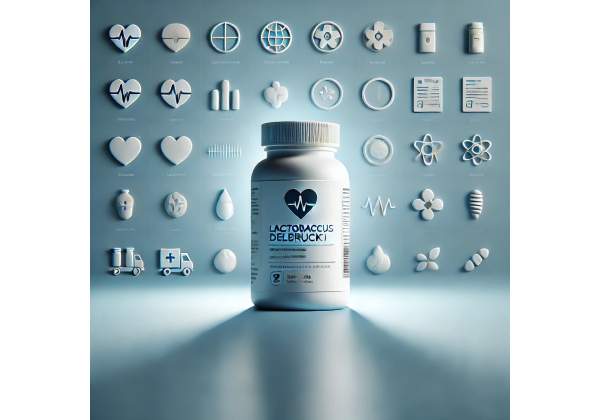
Lactobacillus delbrueckii is a heat-loving lactic acid bacterium best known as one of the two “yogurt starters.” Beyond its culinary role, select strains are used as probiotics and investigated for immune support, upper-respiratory wellness, gut comfort, and as an adjunct during antibiotic or Helicobacter pylori therapy. It survives acidic conditions, produces lactic acid and bioactive metabolites (like exopolysaccharides), and cooperates with Streptococcus thermophilus to ferment milk efficiently. Research focuses heavily on L. delbrueckii subsp. bulgaricus, the subspecies most often found in yogurt and human trials. As with all probiotics, effects are strain-specific and dose-dependent, and benefits appear greatest with daily use. This guide explains how it works, what the evidence shows, practical ways to use it, recommended dosage ranges, and who should avoid it or proceed carefully. You will also find a concise safety section and a summary of credible clinical references to help you make informed, people-first decisions.
Quick Overview
- Supports immune defenses and may reduce common-cold days in some trials.
- Can improve gut comfort during antibiotics and adjunct H. pylori care in select studies.
- Typical supplemental dose: 1–20 billion CFU per day; fermented yogurt servings: 150–200 g daily.
- May cause gas or bloating initially; rare infections reported in severely immunocompromised individuals.
- Avoid or seek medical advice if you have central venous catheters, severe immunosuppression, or short-gut syndrome.
Table of Contents
- What it is and how it works
- Proven benefits and use cases
- How to choose and use it correctly
- Dosage: how much and when
- Safety, side effects, and cautions
- Evidence at a glance
What it is and how it works
Lactobacillus delbrueckii is a Gram-positive, acid-producing bacterium within the Lactobacillaceae family. It thrives in warm, low-oxygen, acidic environments and is naturally adapted to ferment milk sugars. Most human-focused data involve L. delbrueckii subsp. bulgaricus (often abbreviated L. bulgaricus), the classic yogurt culture. In food, it works alongside Streptococcus thermophilus to quickly acidify milk, helping proteins coagulate and giving yogurt its tang.
Mechanisms that matter for health
- Acidification and pathogen control: By producing lactic acid, L. delbrueckii lowers pH and limits growth of pH-sensitive pathogens. Some strains also produce bacteriocins and antimicrobial peptides that further discourage undesirable microbes in the gut and food matrices.
- Barrier and mucosal effects: Strain-dependent exopolysaccharides (EPS) can form a biofilm-like layer and interact with intestinal mucus, which may help reinforce barrier tightness and reduce irritation from transient stressors.
- Immune modulation: Cell wall components (peptidoglycan, lipoteichoic acids) and metabolites interact with gut-associated immune cells. In trials using defined yogurt strains, daily intake has been linked to changes in natural killer cell activity and vaccine antibody responses.
- Metabolic and enzymatic actions: In the gut, L. delbrueckii helps break down lactose and proteins into smaller, more digestible fragments. For people with lactose intolerance, live cultured yogurt can be easier to digest than milk because the bacteria continue acting in the small intestine while you eat.
- Cross-feeding with other microbes: By generating lactate and small molecules, L. delbrueckii supports beneficial, butyrate-producing commensals downstream—an example of cooperative metabolism that can influence stool consistency and comfort.
What “strain-specific” really means
Benefits observed with one strain (for example, an OLL1073R-1 yogurt culture) cannot be assumed for all L. delbrueckii products. Two supplements both labeled “L. delbrueckii” may use different strains with different EPS profiles, stress tolerance, and immune effects. When evaluating products, look for a strain identifier (letters and numbers after the species name), human trial data for that strain, and a viable CFU count through the end of shelf life.
Where it’s found
- Fermented dairy: Live-culture yogurt and some cheeses.
- Probiotic supplements: Single-strain capsules or multi-strain blends designed for immunity, antibiotic support, or general gut wellness.
- Functional foods: Fermented dairy drinks or yogurts that specify the strain on the label.
What it is not
L. delbrueckii is not a cure for chronic disease, nor is it a substitute for medical treatment. It is a supportive food microbe and, in select strains and doses, a probiotic with measurable but modest effects that are best realized with daily, sustained intake.
Proven benefits and use cases
Upper-respiratory support and immune readiness
Randomized, placebo-controlled trials using defined L. delbrueckii subsp. bulgaricus yogurt cultures have reported fewer days with common-cold symptoms and improved markers of immune activity with consistent daily intake. In other studies, daily consumption during the vaccination season enhanced antibody titers after an inactivated influenza vaccine, suggesting a priming effect on mucosal and systemic responses. These outcomes do not eliminate infections; rather, they shift the curve toward milder, shorter episodes for some people.
Antibiotic companion and H. pylori adjunct
During antibiotic therapy, temporary dysbiosis can lead to cramping, loose stools, or bloating. Live cultured yogurt or targeted L. delbrueckii supplements are often used to maintain comfort, reduce perceived GI side effects, and support regularity. In the context of H. pylori treatment, adding yogurt containing L. delbrueckii (often paired with S. thermophilus) to standard regimens has been associated with higher eradication rates and fewer dyspeptic symptoms in some clinical settings. The probiotic is not a therapy on its own, but may help patients tolerate and complete antibiotic courses.
Digestive comfort and lactose handling
Because L. delbrueckii retains lactase activity, cultured yogurt can be better tolerated than milk among people with lactose maldigestion. The active bacteria continue converting lactose in the small intestine during and shortly after the meal, easing post-dairy bloating for many. Consistent intake can also help normalize stool form if your baseline diet is low in fermented foods.
Quality-of-life factors
Exploratory human work with specific yogurt strains has linked daily intake to improvements in sleep quality and psychological quality of life in midlife women. The mechanism is not fully established; hypotheses include gut–brain signaling via microbial metabolites and immune mediators.
Who tends to benefit most
- People who rarely eat fermented foods and want an accessible entry point to probiotics.
- Those seeking seasonal immune support, particularly in environments with frequent viral exposure (schools, open offices).
- Individuals beginning an antibiotic or undergoing H. pylori eradication therapy who want help with GI comfort.
- People with mild lactose intolerance who tolerate yogurt better than milk.
What to expect
Effects are modest and cumulative. For colds and general wellness, plan on daily use for at least 8–12 weeks to judge personal benefit. For antibiotic tolerance, begin within 24 hours of the first antibiotic dose and continue 1–2 weeks after finishing. For H. pylori adjunct use, follow your clinician’s plan and product instructions.
How to choose and use it correctly
1) Pick by strain, not just species
Look for a clear strain code (for example, “Lactobacillus delbrueckii subsp. bulgaricus OLL####”). Search the brand’s site or packaging for human data using that exact strain. When possible, match the form used in studies (yogurt vs. capsule) and the daily CFU.
2) Verify viability at end of shelf life
Labels should state a guaranteed CFU count through expiry (e.g., “≥10 billion CFU at end of shelf life”), not only “at manufacture.” For yogurt, prefer products that explicitly say “live and active cultures,” and keep them refrigerated throughout transport and storage.
3) Fit it into your routine
- Yogurt route: 150–200 g daily of a live-culture yogurt, ideally plain or low in added sugar. Combine with oats, nuts, or fruit to create a balanced breakfast or snack.
- Capsule route: Choose a standalone L. delbrueckii strain or a complementary blend (with S. thermophilus, L. rhamnosus, or Bifidobacterium species) tailored to your goal (immunity, antibiotic support, or regularity).
4) Time it wisely
- For antibiotics: Take the probiotic 2–3 hours away from each antibiotic dose to reduce direct kill. Continue for 7–14 days after.
- For vaccine support (if using a studied yogurt strain): Begin 2–4 weeks before vaccination and continue 4–8 weeks after for consistency.
- For lactose handling: Consume with dairy meals.
5) Storage and handling
Keep capsules in a cool, dry place; some strains require refrigeration—follow the label. For yogurt, maintain the cold chain from store to home. Heat kills live cultures, so add yogurt after hot foods cool.
6) Combine with foundations
A probiotic works best when diet, sleep, and stress are addressed. Pair L. delbrueckii with adequate fiber (25–38 g/day), sleep regularity, and balanced protein to support mucosal immunity and gut motility.
7) Recognize when to switch
If you notice no change after 12 weeks of daily use (outside of antibiotic contexts), consider changing the strain, dose, or delivery form, or discuss with a clinician whether your goal requires a different approach.
Dosage: how much and when
General wellness and immune support
- Yogurt: 150–200 g daily of live-culture yogurt containing a defined L. delbrueckii subsp. bulgaricus strain. Many trials used one serving per day over 8–12 weeks.
- Supplement capsules: 1–20 billion CFU/day, taken once or split. Start at the lower end if you’re new to probiotics.
During antibiotics or H. pylori therapy
- Yogurt or capsules: Aim for ≥10 billion CFU/day of L. delbrueckii (often with S. thermophilus) beginning within 24 hours of antibiotics. Take 2–3 hours apart from each antibiotic dose and continue 7–14 days post-therapy.
- Adjunct to H. pylori treatment: Follow your clinician’s protocol; yogurt servings are typically 1–2 per day during the eradication course.
Lactose intolerance support
- Use with the dairy meal; 1 serving of live-culture yogurt can be enough to noticeably improve tolerance for many people.
Who needs higher doses?
- People under heavy antibiotic pressure, those with high-risk travel exposures, or those seeking seasonal immune support may prefer 10–20 billion CFU/day. If using yogurt, daily consistency matters more than CFU precision.
Titration plan for sensitive users
- Week 1: Half-serving yogurt (or 1–2 billion CFU) with food.
- Week 2: Increase to full serving (or 5–10 billion CFU).
- Week 3+: Adjust to target (10–20 billion CFU) if well tolerated.
Children and older adults
- Children: Use child-labeled products or small yogurt servings; discuss with a pediatrician if the child is under 3 years or has medical complexity.
- Older adults: Standard adult servings are appropriate; yogurt forms can aid protein intake and hydration.
Timing and adherence tips
Set a same-time daily cue (breakfast or evening snack). If you miss a day, simply resume; benefits accrue with weeks of consecutive use.
Safety, side effects, and cautions
Typical side effects
When starting L. delbrueckii, some people experience temporary gas, bloating, or stool changes for several days as the gut adjusts. These usually settle as your microbiome accommodates the new input. Taking with food and gradually titrating the dose can help.
Allergy considerations
Capsules may contain residual dairy components depending on how they’re grown; yogurt obviously contains milk. If you have cow’s milk allergy (not lactose intolerance), choose products carefully or avoid dairy-based forms. Always read excipients if you have soy, gluten, or egg allergies.
Who should not use without medical advice
- Severely immunocompromised individuals (e.g., profound neutropenia, post-transplant, active chemotherapy).
- Those with central venous catheters or prosthetic heart valves due to rare case reports of probiotic translocation.
- Critical illness or short-gut syndrome.
- Preterm infants unless under specialist guidance.
Medication interactions
No direct drug–microbe interactions are expected, but antibiotics can kill probiotics if taken together; keep a 2–3 hour buffer. If you take immunosuppressants, discuss probiotic use with your clinician.
Pregnancy and breastfeeding
Live-culture yogurt is commonly consumed and generally considered acceptable in healthy pregnancies when pasteurized milk is used to make the yogurt. For high-dose supplements, consult your obstetric provider.
Quality and contamination risk
Select brands that disclose strain IDs, CFU at expiry, third-party testing, and clear storage instructions. For yogurt, choose pasteurized-milk products fermented with live cultures and keep them refrigerated.
Stop and seek care if
You develop fever, persistent abdominal pain, blood in stool, or signs of infection, particularly if you are in a high-risk medical group.
Evidence at a glance
Study types you will see
- Randomized controlled trials (RCTs): Most informative for symptom outcomes (cold duration, antibody titers, GI comfort).
- Adjunctive therapy trials: Adding L. delbrueckii yogurt to standard regimens, such as H. pylori eradication or post-antibiotic care.
- Mechanistic and translational studies: Explore survival through the GI tract, EPS production, and immune signaling.
Key signals from human studies
- Fewer cold-symptom days and improved immune markers with daily, strain-defined L. delbrueckii yogurt in generally healthy adults during cold/flu seasons.
- Increased vaccine antibody titers when consumed around influenza vaccination periods in healthy adults, with benefits tied to continuous daily intake of the studied strain.
- Better tolerance of antibiotic or H. pylori regimens, with improved eradication rates in some studies when yogurt containing L. delbrueckii (often with S. thermophilus) is added to therapy.
- Quality-of-life improvements (sleep and menopausal symptom scores) reported in a midlife women cohort consuming a defined strain of L. delbrueckii yogurt.
What the data do not show
- No evidence that L. delbrueckii prevents all infections or replaces vaccines or prescribed therapies.
- Benefits are strain-specific; not all products will reproduce trial results.
- Magnitude of effect is modest, and individual responses vary.
How to apply the evidence
- Match your goal to a studied form and strain when possible.
- Use daily, not sporadically.
- Set realistic expectations: think “support” and “comfort,” not dramatic cures.
References
- Improved immunity and prevention of colds by yogurt containing Lactobacillus delbrueckii ssp. bulgaricus OLL1073R-1: a randomized, double-blind, placebo-controlled trial 2010 (RCT)
- Consumption of yogurt fermented with Lactobacillus delbrueckii ssp. bulgaricus OLL1073R-1 augments serum antibody titers against seasonal influenza vaccine in healthy adults: Randomized, double-blind, placebo-controlled trials 2022 (RCT)
- Consumption of OLL1073R-1 yogurt containing Lactobacillus delbrueckii ssp. bulgaricus improves psychological quality of life, menopausal symptoms and sleep quality in women: a randomized controlled trial 2021 (RCT)
- Improved Helicobacter pylori eradication rate of tailored triple therapy by adding Lactobacillus delbrueckii and Streptococcus thermophilus in Northeast region of Thailand: a prospective randomized controlled clinical trial 2015 (RCT)
- Survival of Lactobacillus delbrueckii subsp. bulgaricus and Streptococcus thermophilus in the terminal ileum of fistulated Göttingen minipigs 2001 (Mechanistic)
Medical Disclaimer
This content is for educational purposes only and is not a substitute for professional medical advice, diagnosis, or treatment. Always seek the advice of your physician or other qualified health provider with questions about a medical condition, a supplement, or any health goals. Never disregard professional medical advice or delay seeking it because of something you have read here. If you are immunocompromised, have major health conditions, or are pregnant or breastfeeding, discuss probiotic use with your clinician before starting.
If you found this guide helpful, consider sharing it with a friend or colleague on Facebook, X (formerly Twitter), or your favorite platform, and follow us for future evidence-based articles. Your support helps us continue producing high-quality, reader-first content.










